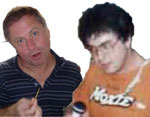Clams Ahoy!
Everything you always wanted to know about Clams but were afraid to ask!!
What Do Clams Eat?
Clams - The All Purpose Bivalve
Clams are filter-feeders. Ocean clams feed at high tide, when the sand in which they are buried is covered by water. At low tide, clams wait for the water to return. Freshwater clams feed all the time.
Clams extend their siphons or “necks” to take in water for oxygen and food. They exhale the water through the siphon after respiration and removal of nutritious particulates (ingestion). “Food” to a clam is the suspended particles present in the water of its habitat. Much of this mass is made up of plankton, ubiquitous at the very top level of ocean water and otherwise circulated through all but the deepest (intercontinental) sea levels. For clams to eat, the water available to them must be in motion.
Clams respirate through the movement of water across their gills, although some O2 intake takes place along the body mantle. Water is propelled across the gills and the body proper by means of cilia, tiny hairlike protrusions of protein. O2 intake is low, and estimated at under ten percent of that present in the amount of total water processed.
What constitutes the biomass clams consume? Whatever is floating nearby. Clams are indiscriminate feeders. Suspended particles may include products of decomposition from dead sea animals, plant protozoans, tiny pieces of seaweed and so on but it is microorganisms plants need to build their bodies, which are almost 100% protein. Saltwater clams are not fed when cultivated, and gather their nutrition from particles common to the area in which they are berthed. Freshwater clams, as in a private tank, need not be fed at all should other sea animals be present: they will take in particles of fish food along with fish excrement and flaked-off skin cells. Should the freshwater clams exist in isolation, cultivated “green water” available at pet shops, along with dried seaweed containing spirulina is good nutrition.
Not all substances taken in by clams are healthful to humans. Common contaminants are the consequence of runoff from nearby streets and homes into the clam beds. This runoff may contain petroleum distillates, heavy metals, antifreeze, pesticides and other dangerous chemicals. Heavy metals such as chromium will build up in a clam’s flesh over time without killing it, leaving it dangerous for human consumption. More often, seasonal microorganism blooms make clams unsafe to eat. Dynoflagetllates, a type of single-celled photosynthetic animal are a natural part of the plankton food chain. They are characterized by two flagella, whiplike “tails” that permit limited locomotion. Dynoflagellates are indigenous to the Atlantic and Pacific coasts of the United States. They become hazardous only at times of “red tide,” coherent blooms which are monitored each year by oceanographers. Should red tide infest clamming grounds, the animals are no longer safe to harvest or eat. This is because red tide dynoflagellates secrete a type of neurotoxin known as cegrotoxins. These interfere with the movement of sodium ions (Na+) across human cell membranes thus impairing nerve and muscle communication. In rare instances, red tide infection results in paralytic shellfish poisoning (PSP). The condition is curable with prompt treatment, but left untreated can result in breathing problems and eventually death by asphyxiation.
Dynoflagellates are also known as the source of “cold light,” bioluminescence sometimes observed by nighttime swimmers. This photo effect results when the luciferin in dynoflagellates is broken down by luciferase in the presence of oxygen and adeninotriphosphate (ATP), and the dynoflagellate is disturbed by nearby motion. To the swimmer, faint illumination, with a green, yellow or bluish cast follows arm and leg motion through the water.
Non-fatal poisoning from contaminated clams is not unusual in the US, particularly in summer months. Fortunately, most clam-borne illness is caused by clams that have ingested septic runoff. Eating such a clam is likely to produce a one to two-day bout with chills, violent nausea and fever, but the condition is not life-threatening except to those with impaired immune systems. Red tide poisoning can be fatal. If you have any doubts about illness caused by eating bad clams, take the patient to the hospital immediately. Clamming beds are tested each year by local governments, generally at the town level per county rules. Red tide blooms are closely tracked by organizations such as the Woods Hole (Massachusetts) and Scrippts (California) Oceanographic Institutes. When a red tide bloom approaches shore, warnings are posted by law. Some red tide blooms never present a danger to humans, because they stay out at sea. In recent years, red tide blooms beginning in the Gulf of Maine and spreading south and west have become more of a concern. Whether this is due to an increase in atmospheric CO2 over time (“global warming”) is not yet known.
 Hi,
we are Ted and John, just two guys who love Clams and other seafood.
Hi,
we are Ted and John, just two guys who love Clams and other seafood.